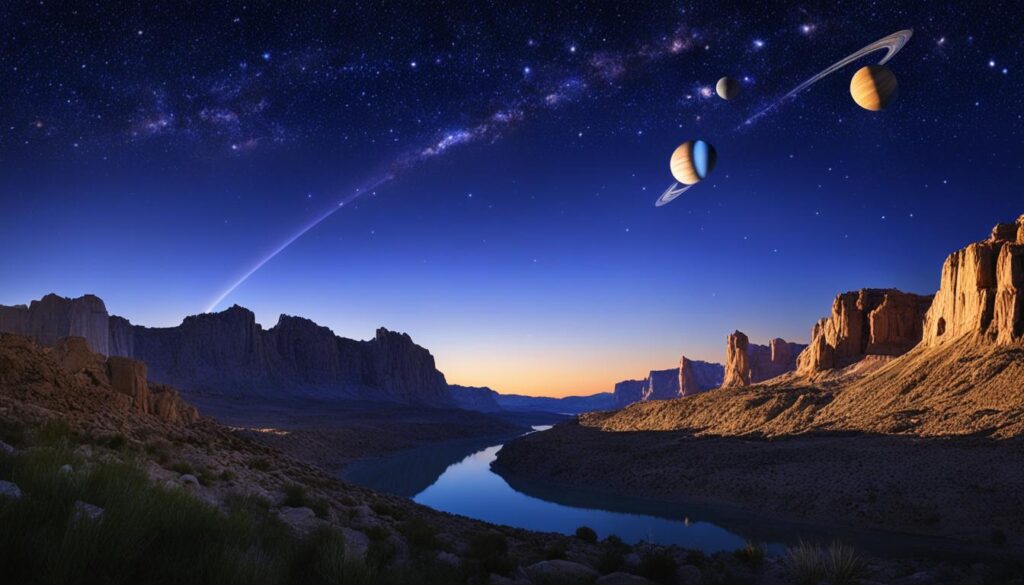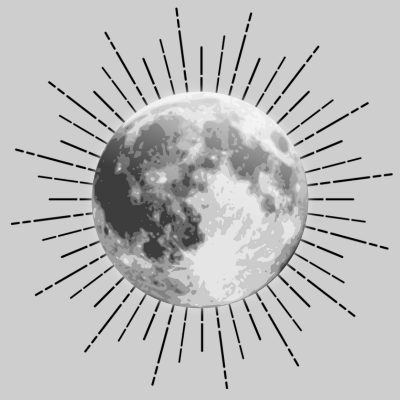Get ready for an extraordinary celestial event – the convergence of Venus and Jupiter. This planetary alignment is a rare spectacle that will captivate skywatchers and astronomy enthusiasts alike. On March 1st and 2nd, 2023, Venus and Jupiter will come remarkably close, creating a breathtaking sight in the night sky.


During this celestial dance, the two brightest planets in our night sky will be separated by a mere half-a-degree. This is the closest and most easily visible meeting of Venus and Jupiter since 2015, and we won’t see it again until 2039. Don’t miss this opportunity to witness this remarkable astronomical phenomenon.
As the evening falls, look west after sunset, and you’ll be greeted by the brilliance of Venus and Jupiter. Their proximity will create a breathtaking view of these celestial wonders. Whether you’re an experienced stargazer or new to skywatching, this convergence is an event you won’t want to miss.
Stay tuned for the upcoming sections of our article to learn more about the mesmerizing dance of the planets, the distinct characteristics of Venus and Jupiter, and how to observe this celestial show in all its glory.
The Dance of the Planets: Understanding Planetary Motion and Conjunctions
Planetary motion follows the laws of physics and has been studied for centuries. The planets move in predictable orbits around the Sun, and their positions relative to each other can be accurately predicted. This dance of the planets is dictated by Kepler’s laws of planetary motion and is so precise that it requires no corrections over the timescale of many centuries.
Conjunctions, such as the convergence of Venus and Jupiter, occur when two planets appear close together in the sky. These events are a result of the planets’ orbits and can be observed and appreciated by skywatchers.
- Planetary motion is governed by Kepler’s laws of planetary motion.
- These laws ensure that the planets move in predictable orbits around the Sun.
- The positions of the planets relative to each other can be accurately predicted.
- Conjunctions, like the convergence of Venus and Jupiter, occur when two planets appear close together in the sky.
- Observing and appreciating the dance of the planets can provide a deeper understanding of our solar system’s mechanics.
Venus: The Brightest Star-Like Object in the Night Sky
Venus, also known as the evening star or the morning star, is an extraordinary planet that commands attention in the night sky. It shines with unparalleled brilliance, making it the brightest planet and surpassing all other celestial objects, except for the Sun and Moon.
What sets Venus apart is its steadfast brightness, which allows even novice skywatchers to easily locate it. After the sun sets, Venus often claims the title of the first “light” to appear in the sky, and it lingers long after other stars fade away, earning its reputation as the last to vanish before sunrise.
This remarkable phenomenon is attributed to Venus’s strategic position relative to the Sun and its swift movement across the sky. There are certain periods when Venus reaches its farthest distance from the Sun and its greatest elongation, occurring approximately 71 days before or after it achieves its maximum brightness. During these moments, Venus shines with unmatched radiance, becoming an unmistakable sight.
Galileo Galilei made a significant discovery about Venus’s appearance by observing its phases. Similar to Earth’s Moon, Venus exhibits various phases as it orbits around the Sun, causing its visibility and apparent size to change in the night sky. These distinct phases contribute to the allure and unique appearances of Venus, captivating skywatchers worldwide.
Image of Venus in the Night Sky:
Experience the mesmerizing beauty of Venus, the brightest planet in the night sky. Witness its constant radiance and graceful movements, making it a brilliant centerpiece of the celestial panorama.
Jupiter: The King of the Skies and its Moon Dance
Jupiter, the largest planet in our solar system, dominates the night sky with its majestic presence. Its immense size and radiant glow make it impossible to miss. But Jupiter’s captivating beauty goes beyond its grandeur. It plays host to a remarkable display known as the “moon dance.”
With its strong gravitational pull, Jupiter has captured a collection of moons, affectionately called the Galilean moons after their discoverer, Galileo Galilei. These four moons, namely Io, Europa, Ganymede, and Callisto, orbit around Jupiter in a mesmerizing dance, accompanying the planet on its celestial journey.
Observing Jupiter’s Galilean moons is a thrilling experience, even with small telescopes or binoculars. Through these optical aids, you can witness the counterclockwise orbit of the moons around Jupiter, mirroring the planets’ dance around the Sun. Each moon has its own unique characteristics and appearance, adding depth and intrigue to the celestial performance.
The Galilean moons serve as a testament to the laws of gravity and planetary motion, offering a captivating perspective on the intricate workings of our solar system. Their gravitational interactions create a dynamic interplay that magnifies the cosmic splendor.
During a close conjunction of Venus and Jupiter, which is a rare occurrence, you can witness both Venus’s phases and Jupiter’s moons together, amplifying the celestial spectacle. This rare combination showcases the harmonious coordination between the planets and their accompanying moons, truly highlighting the wonders of our universe.
The Mechanics Behind Conjunctions: Factors Affecting the Frequency of Venus-Jupiter Alignments
While the movements of Venus and Jupiter are relatively predictable, several factors influence the frequency of their conjunctions and the occurrence of celestial events like the upcoming convergence of Venus and Jupiter.
According to Newton’s theory of gravity, the planets follow perfect elliptical orbits. However, the introduction of general relativity reveals that precession effects cause these orbits to shift over time. As a result, the positions of Venus and Jupiter gradually change, affecting their alignment.
Furthermore, the motion of both planets relative to the Sun contributes to the rarity of close conjunctions. Venus, with its shorter orbital period, moves faster than Jupiter, which has a longer orbital period. Consequently, their meeting points vary over time, making close conjunctions less frequent.
These factors, including orbital mechanics and the planets’ different orbital periods, create the unique conditions necessary for the infrequent occurrences of events such as the convergence of Venus and Jupiter. Understanding these mechanics enhances our appreciation of these spectacular astronomical events.
The beautifully orchestrated dance of the planets is a testament to the intricate workings of our solar system. This image represents the alignment of Venus and Jupiter, two celestial bodies that captivate skywatchers with their celestial rendezvous.
Don’t Miss the Spectacular Show: How to Observe the Venus-Jupiter Conjunction
To witness the celestial spectacle of the Venus-Jupiter convergence, look west after sunset on March 1st and 2nd, 2023. Find a location with a clear western horizon and a clear view of the sky. Venus and Jupiter will appear close together, approximately one degree apart, just above the horizon. With the naked eye, you can observe their brilliance and distinguish Venus as the brighter of the two.
If you have binoculars or a telescope, you can enhance your view and potentially see the phases of Venus and Jupiter’s moons. Remember to check the weather conditions for clear skies to ensure optimal viewing.
Observing Tips:
- Choose a location away from city lights for better sky visibility.
- Arrive early to set up your equipment and allow your eyes to adjust to the darkness.
- Use a star chart or smartphone app to locate Venus and Jupiter in the sky.
- Consider using a tripod for stability and to minimize shaking.
- Experiment with different exposure settings on your camera to capture the best images.
By following these tips, you can make the most of this astronomical event and have a memorable skywatching experience.
Conclusion
The convergence of Venus and Jupiter is a rare and captivating celestial event that shouldn’t be missed. This astronomical phenomenon offers a unique opportunity for skywatchers to witness the mesmerizing dance of the planets and marvel at the wonders of our solar system.
Whether you observe with the naked eye or through a telescope, the Venus-Jupiter conjunction provides a visual feast that showcases the beauty and splendor of the universe. It’s a chance to connect with the vastness of space and gain a deeper understanding of our place in the cosmos.
So mark your calendars and prepare to be awed by the stunning convergence of Venus and Jupiter on March 1st and 2nd, 2023. Don’t miss this extraordinary celestial event that will leave you with a sense of wonder and a renewed appreciation for the astronomical miracles that unfold above us.
FAQ
What is the convergence of Venus and Jupiter?
The convergence of Venus and Jupiter is a rare celestial event where the two brightest planets in Earth’s night sky come close together, creating a spectacular sight.
When is the upcoming convergence of Venus and Jupiter?
The convergence of Venus and Jupiter is set to occur on March 1st and 2nd, 2023.
How often does the convergence of Venus and Jupiter happen?
Close conjunctions of Venus and Jupiter, like the upcoming convergence, are relatively rare. The next one won’t happen until 2039.
What causes the convergence of Venus and Jupiter?
Conjunctions occur due to the planets’ orbits and their positions relative to each other. The dance of the planets follows the laws of planetary motion, like Kepler’s laws, which can be predicted with great accuracy.
Why is Venus known as the brightest planet in the night sky?
Venus is the brightest natural object in Earth’s skies, second only to the Sun and Moon. Its brightness is constant, making it easy to locate in the night sky.
Can I observe the moons of Jupiter during the convergence?
Yes, if you have binoculars or a telescope, you may be able to observe the moons of Jupiter, known as the Galilean moons, during the convergence of Venus and Jupiter.
Are the movements of Venus and Jupiter predictable?
Yes, the movements of Venus and Jupiter follow predictable orbits around the Sun. However, factors like general relativity and the planets’ different orbital periods contribute to the rarity of close conjunctions.
How can I observe the convergence of Venus and Jupiter?
To witness the convergence, look west after sunset on March 1st and 2nd, 2023. Find a location with a clear western horizon and a clear view of the sky. You can observe the brilliance of Venus and Jupiter with the naked eye, but binoculars or a telescope can enhance your view.
What can I expect to see during the convergence of Venus and Jupiter?
During the convergence, you can expect to see Venus and Jupiter close together in the sky, with Venus appearing brighter. If you have binoculars or a telescope, you may also be able to see the phases of Venus and Jupiter’s moons.
Why shouldn’t I miss the convergence of Venus and Jupiter?
The convergence of Venus and Jupiter is a rare and captivating celestial event that showcases the beauty and wonder of the universe. It’s a unique opportunity to witness the dance of the planets and appreciate the intricate mechanics of our solar system.
